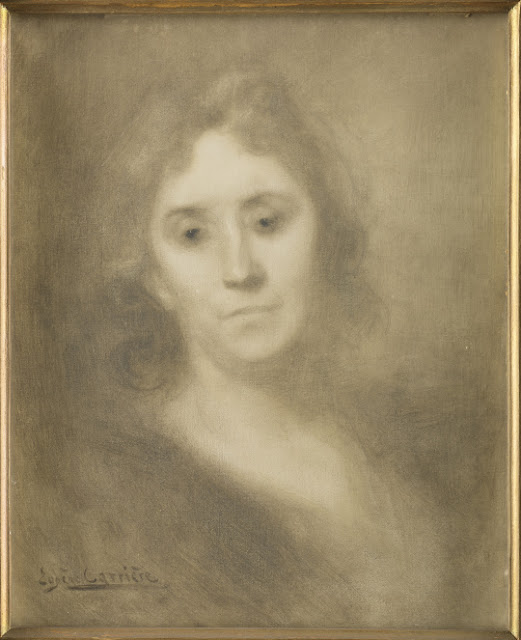He was born at Gournay-sur-Marne. He studied at the École des Beaux-Arts in Paris and later under Cabanel. During the Franco-Prussian War he passed some time as a prisoner in Dresden, where the art of Rubens made a lasting impression on him, as may be seen in the glowing colors of his early paintings. About 1890 he adopted the gray, misty-color scheme with contrasts of light and shadow, so characteristic of his art, but which no other artist has been able to imitate without affectation.
Eugène Carrière, (1849-1906)
Young Mother, c. 1879
Study for a painting for the Salon of 1879
Oil on Canvas
Musée des Beaux-Arts, Rouen, Normandy, France.
Eugène Carrière, (1849-1906)
The young mother, c. 1879
Oil on canvas
115 x 146 cm
Musée des Beaux-Arts de Rouen
His themes usually are scenes of his domestic life, and he repeatedly introduced the likeness of his wife in his paintings. The first of these, The Young Mother (1879), is now in the Musée des Beaux-Arts de Rouen.
Eugène Carrière, (1849-1906)
The young mother (1897-1900)
Oil on canvas
357 x 279 cm
Musée des Beaux-Arts de Rouen
Eugène Carrière, (1849-1906)
L'enfant malade, c. 1885
Oil on canvas
Eugène Carrière, (1849-1906)
The sick child, c. 1885
Oil on canvas
H. 101; W. 82 cm
Grand Palais (Musée d'Orsay)
Gustave Geffroy writes in La Vie artisticof 1892: "Divine motherhood, the religious motif which is displayed on all the canvases of old Italy, Carrière took it up, and made it the bourgeois subject of modern motherhood. It is no longer the quiet and rested motherhood of times of faith, it is the motherhood of the century of pessimism, the motherhood of the dark thoughts of mothers whose anxious embraces, and the anxious wrapping of the arms around her child's body, seem perpetually in defense against illness and death." It is indeed the portrait of the painter's wife, tenderly embracing one of his children, aged six, who was to die the same year this painting is painted.
Offered for sale in 1920, when Carrière's studio was dispersed, this particularly moving canvas was finally bought by the artist's family and offered three years later to the Louvre. More on this painting
It was followed by, The Sick Child (Montargis), The First Communion (Toulon), and the highly praised 1887 portrait of the sculptor Louis-Henri Devillez.
Eugène Carrière, (1849–1906)
The First Communion, circa 1896
Oil on canvas
25 3/4 x 21 in. (65.4 x 53.3 cm)
Metropolitan Museum of Art
Eugène Carrière, (1849–1906)
The Sculptor Louis-Henri Devillez in His Studio
Oil on canvas
220.5 x 181 cms | 86 3/4 x 71 1/4 ins
Musee d'Orsay
Louis Henri Devurez , born in Mons on July 19 , 1855 and died in Ixelles on February 2 , 1941, was a Belgian sculptor, draftsman, painter and medalist.
Son of Alphonse Devurez, one of the founders of the École des Mines de Mons, he studied with Auguste Danse , André Brunin and Charles Van Oemberg at the Académie de Mons then with Jules Cavelier at the École des beaux-arts in Paris 1, he specializes in portraiture.
Member of the National Society of Fine Arts and French artists Salon, he won a medal of 3rd class at the Paris Exposition in 1889.
Devivez formed a Workshop in Paris and collected the paintings of, among others, Eugène Carrière 4 , Maurice Denis 5 , Paul Gauguin , Édouard Manet , François-Joseph Navez or Claude Monet. More on Louis Henri Devurez
Carrière was one of the leaders in the secessionist movement, which led to the founding of the Société Nationale des Beaux-Arts.
Eugène Carrière, (1849-1906)
The Sleep, c. 1890
Oil on canvas
66.2 x 65.8 cm
Städel Museum, Frankfurt am Main
At the Société, Carrière exhibited, among other works, Sleep (1890), the celebrated portrait of Paul Verlaine (1891, Luxembourg), Maternity (1892, Luxembourg), Christ on the Cross (1897), and Madame Menard-Dorian (1906).
Eugène Carrière, (1849-1906)
Paul Verlaine (1890)
Oil on canvas
149.8x 121.9 cm
Musée du Louvre, Paris
Eugène Carrière, (1849-1906)
Maternity, c. 1892
Oil on canvas
37 3/4 x 45 3/4" (95.9 x 116.2 cm)
The Museum of Modern Art
Eugène Carrière, (1849-1906)
Christ on the cross, c. 1897
oil on canvas
H. 227.0; L. 130.0 cm.
Orsay museum, Paris, France
Eugène Carrière, (1849-1906)
Madame Menard-Dorian (1906)
Musée Albert-André
Carrière played an influential role as an art teacher at Académie de La Palette.
He also modeled a monument to Verlaine in the style of Rodin.
Please visit my other blogs: Art
Collector, Mythology, Marine
Art, Portrait of a Lady, The
Orientalist, Art of the Nude and The
Canals of Venice, Middle
East Artists, 365
Saints and 365 Days, also visit my Boards on Pinterest
Images are copyright of their respective owners, assignees or others.
Some Images may be subject to copyright
I don't own any of these images - credit is always given when due unless
it is unknown to me. if I post your images without your permission, please tell
me.
I do not sell art, art prints, framed posters or reproductions. Ads are
shown only to compensate the hosting expenses.
If you enjoyed this post, please share with friends and family.
Thank you for visiting my blog and also for liking its posts and pages.
Please note that the content of this post primarily consists of articles
available from Wikipedia or other free sources online.
















.jpg)

No comments:
Post a Comment